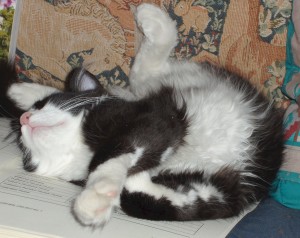 Jackson demonstrates a little kitty yoga for you. Dare you to replicate this position.
Jackson demonstrates a little kitty yoga for you. Dare you to replicate this position.
I’ve been working away on the sequel to Rogue’s Pawn, simply titled RP2 for now. I had been going fast on it, then I slowed down. It happened right as I neared the Act I climax. Usually I don’t have this problem, but usually I’m not writing a sequel.
Now, for those of you not hugely up on story structure, most stories fall roughly into three acts. This is traditional, embedded-in-the-subconscious hum storytelling. Jokes traditionally come in three parts. Magic tricks have three stages: the pledge, the turn and the prestige. (Brilliantly demonstrated in the movie The Prestige.) Shakespeare’s plays generally are in three acts (if there’s an Act IV, it usually serves as an epilogue). You can think of it in the classic terms of “boy meets girl, boy loses girl, boy gets girl back” or “get your hero up a tree, throw rocks at him, get him back down.”
So, Act I for a sequel is all about getting my characters back up a tree. I say specifically “back up the tree” because I just finished getting them out of a damn tree in the first book. It’s not that easy to get them back up the tree without making them seem stubborn or stupid or just plain self-destructive.
Plus, in the sequel, you need to ground readers in the world and ongoing threads established in the first book so that they know enough to skip reading the first book, but not so much that readers of the first book throw the second one against the wall in frustration. (A reader recently told me she did this with the most recent book in an ongoing, very long series. She felt like every other paragraph was devoted to summarizing “the story so far,” to the point that would have thrown it against the wall, except she values her ereader.)
It’s a lot of stuff to fold into the first act. Especially if you want the story to be interesting, too.
I felt like I was up against a wall, in that final scene of the first act. I’d built and built up to that point, I had an idea what needed to happen, where everyone needed to be mentally, to catapult us into the rest of the adventure (hurtling rocks – coming right up!), but I just couldn’t seem to get it into place.
Now, some writers will switch off at this point. They’ll switch to another project or write a scene from later in the story. I can see why this works – it relieves the pressure of having your creative face mashed up against that plot wall.
But, for me, all the juice is in sticking it out.
I went back and reread what I had so far – about 100 pages – and tightened and polished as I went. I worked my way back up to that wall, my steps slowing with every page as I neared that final scene. Yes, it was painful and unfulfilling. The last 20 pages took me two days of sticking it out.
Finally, the wall crumbled.
The resistance gave way and the world on the other side opened up.
Juicy, indeed.
YAY! We like those walls to crumble.
Yes, we do!